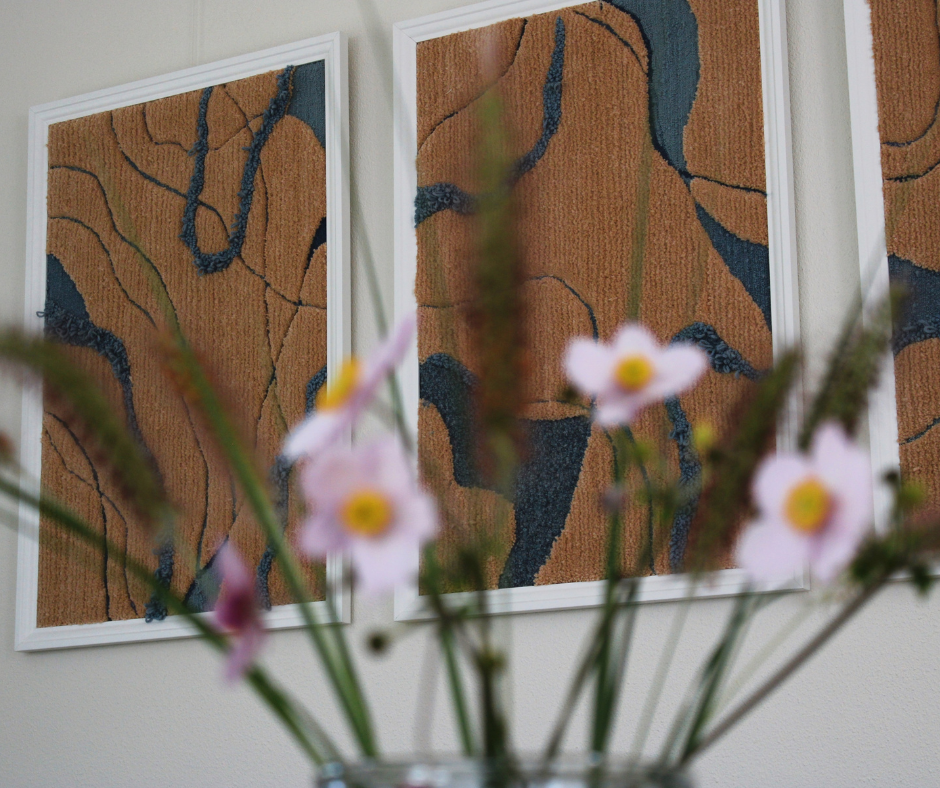
10 tips for you as a novice tufter
Share
Once I held the tufting gun in my hands for the first time and I thought: ‘how am I going to do this?!’ I had everything I needed (or so I thought), everything was ready and I was just staring at my empty monk’s cloth… That’s why I have 10 tips for you that I wish I had known before I started tufting.
1. Choose the right tufting gun
There are so many different tufting guns for sale that you can’t see the forest for the trees. Especially as a beginner you wonder: AK I? AK II? AK-V? AK-DUO High Pile? What are the differences? I will list them for you. In this overview you will only find the AK tufting machines, but there are more different types. I only work with AK tufting guns myself and the tufting machines from this list are for sale in the webshop.- The AK I tufts only cut piles with heigths between 8 – 18 mm ad weighs 2.1 kg.
- The AK II tufts only loop piles with heights between 4 – 14 mm and weighs 2.1 kg.
- The AK DUO Pro tufts both cut piles and loop piles with heights between 5 – 18 mm and weighs 2.1 kg.
- The AK-V tufts both cut piles and loop piles with heights between 8 – 16 mm and weighs 1.4 kg.
- The AK DUO High Pile tufts cut piles and loop piles with heights between 35 -45 mm and weighs 2.3 kg.
The AK-V is the successor to the AK-DUO Pro. It is lighter, a lot quieter and has a display with a speedometer on the back. This makes it easy to keep an eye on whether you are drawing your lines at the same speed. Handy, because this ensures an even density in your tufted carpet. There is also a light on the head near the needle.
2. Research into the cut pile and loop pile technique
When I started, it became practical to start with a tufting gun with punched pile tufting. My source of inspiration was someone who only worked with the AK II (loop pile tufting machine). You guessed it… I chose the AK II and my first tufted carpets were loop pile tufted carpets. First of all, I would say: search on Google, Instagram, TikTok or another platform for tufters and see what you like. Then decide what suits you best. Loop pile is not more difficult than cut pile. It just works differently. But what is the difference?
Cut pile
Tufting machines that tuft cut pile, cut each thread with built in scissors when the thread is tufted through your cloth with the needle. This happens automatically. There are scissors hidden under the needle. The effect is a pile carpet. Your carpet is soft and fluffy. After tufting, you can finish your rug with duckbill scissors or a trimmer, so that you can make the lines, create depth of 3D effects in your rug you can make. That is not possible with loop pile.
Loop pile
Tufting machines that tuft loop pile, do not have scissors incorporated in the machine. So you cut your yarn yourself with scissors after each set line. The needle tufts your yarn through the cloth. Just after the needle goes back and forth, a plate comes under the needle back and forth, which ensures that your yarn stays in place in the cloth. This creates small (or large) loops. Instead of a pile carpet, you get low or high loops carpet. Because there are no scissors in your machine, you hold a pair of scissors yourself. This takes some time getting used to, at least that's what I thought. But you quickly get the hang of it. With a loop pile carpet, you also place the lines a little closer together than with a cut pile carpet. Your carpet is shorter and your wool is shot through the cloth in small loops. This makes it less fluffy on the front and you will sooner see your tufting cloth through your wool on the front if you do not place them close enough together.
3. Make a sturdy frame for tufting
Important! Make sure your frame is made of thick enough wood and that your frame has enough support at each corner. My first frame had no support at the top of the corners. Because I put a lot of force on the cloth with the tufting gun (which is also necessary), my frame quickly started to loosen and wobble. There are many ways to build a good tufting frame. In my manual Build your own tufting frame you can read which type of wood, materials, dimensions, etc. are useful and you can read tips about what to look out for.
4. Choose the right cloth for tufting
There is quite a bit of choice in different types of cloth. But what is the difference? Here is an explanation of some different options:
100% cotton monk's cloth (often completely white, without lines)
If you are going for an environmentally conscious choice, then 100% cotton is something for you. This type is not available in my webshop, but I will put it in this list. That way you know that there is a choice if you are looking for it. I do not find this type very pleasant to tuft. It is quite fragile and sensitive fabric.
Combination polyester - cotton (often white cloth with yellow lines or vice versa)
This is cloth that is often used by tufters. It works fine and is less fragile, but still more fragile and sensitive than the fabric that is for sale in my webshop. This is because there is relatively a lot of cotton in this fabric. Polyester provides the strength.
Combination polyester – cotton (grey cloth with white lines)
This cloth is for sale in the webshop and in my opinion is a very nice material to tuft with. It is sturdy and the least vulnerable type of fabric to make tears and holes in. Of course that can still happen, but this is the fabric that is most resistant to that. That is because the ratio between cotton and polyester is different in this fabric. There is more polyester in it than cotton and that makes the fabric strong and less stretchy than the other two examples.
5. Stretch the canvas straight and tight
In the beginning, you will have to figure out how to do this best. There are lines on your canvas. They are there for a reason. Make sure that you stretch the lines as straight as possible and that there are no bends visible. This helps to tuft your design as nicely as possible.
With small frames, I start by clamping the canvas from top to bottom on the sides to the nail strips. I pull sideways and downwards at the same time and try to keep the lines as straight as possible. Then I tighten the top and bottom and keep re-tightening places where the canvas is not yet tight enough or not yet straight enough. This can sometimes take quite a while.
On large frames (for example frames of 2 by 2 meters) I simply hang the canvas over the frame and start to stretch the canvas a bit on all sides. I stretch the canvas tighter and straighter along each side until I am satisfied.
You also want to stretch your canvas as tightly as possible. If you think it cannot be tighter, then you are doing well. My tip: only start tufting your cloth when you can drum on it and hear a sound like you are playing a drum. If you have stretched your cloth too loosely on the frame, you will more easily make tears and holes with the tufting machine. The needle of the machine moves back and forth at high speed. This then ensures that the cloth also moves. If the cloth moves a lot because it is stretched too loosely, then the needle and the scissors in the machine can easily cause holes and tears. You will also notice that you have to tighten your cloth a little more every now and then during tufting.
6. Choose a projector to draw your design
Once I have made or found a design, I put it on the canvas with a projector. Are you good at drawing? Then it is also fun to draw something yourself. When choosing a projector, make sure you buy one that also puts your design visible on the canvas in daylight. You do this by choosing one with at least 5000 lumens and that can also 'beam' your entire frame in a small space, so that it can be close by and shine wide and high enough.
7. Draw in mirror image
Make sure that you always draw your design in mirror image on your canvas! You tuft on the back of your dress, so your design will come out in mirror image on the front. This is especially important if you tuft texts.
8. Get a threader
This was not standard with my tufting gun when I started, but it is really necessary. You can't pull the wool through the machine with your hand. So I did this with a piece of wire that I happened to have lying around. But a threader is really handy to pull your wool through the tufting gun. You can find it here in the webshop.
10. Choose the right glue to finish your rug
Never choose water sealant!
There are different types of glues to finish rugs with. With my first rug, I made the big mistake of accidentally using the bucket of Water Sealant from Bison instead of the Flooring Glue from Bison. Result? A rug that had dried so hard that it could no longer be rolled up and it smelled terrible. REALLY terrible.
Liquid latex
Then you also have glue based on latex. You can use liquid latex if, for example, you can easily lay your frame flat. It is so liquid that it is very inconvenient to apply to a standing frame. Liquid latex dries very flexible. It is fine to use for small rugs that you want to put on a table or on the floor. I would not use it for wall hangings. In addition, a bit of firmness is very nice! You want your rug to hang nice and tight (as tight as possible in any case). Then a stronger glue works well again.
Tufting Glue
The Tufting glue from the webshop is a glue that dries on average firm. Your carpet can still be rolled up and is flexible, but certainly offers firmness in the case of a wall hanging on the wall. The glue also hardly stinks. You can smell it, but it is not a very present smell, unlike other floor covering glues. In my opinion, floor covering glues are the best glues to glue a tufted carpet with. However, there is quite a lot of difference between the types in terms of smell, how firm it dries and certainly also in the costs.
